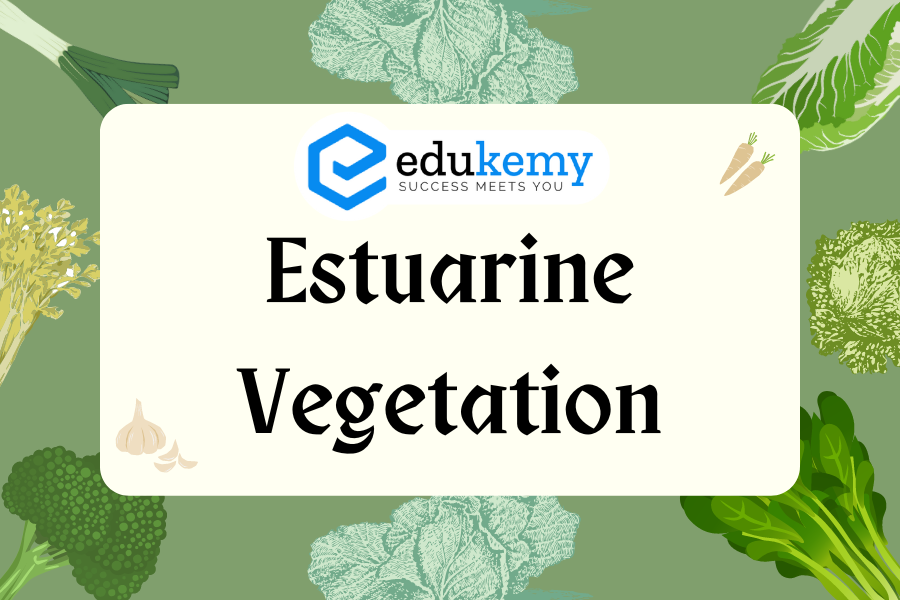- Estuarine vegetation refers to the diverse plant life that thrives in the unique and dynamic ecosystems of estuaries.
- Estuaries are transitional areas where freshwater from rivers or streams meets and mixes with saltwater from the ocean.
- These environments are characterized by fluctuating salinity levels, tidal influences, and a mix of sediments, creating a challenging yet productive habitat for various plant species.
- Estuarine vegetation plays a crucial role in the overall health and functioning of estuarine ecosystems.
Contents
- 1 FAQs – Estuarine Vegetation:
- 1.1 Q1: What is estuarine vegetation, and why is it significant?
- 1.2 Q2: How do estuarine plants adapt to salinity variations?
- 1.3 Q3: What are halophytes, and how do they contribute to estuarine ecosystems?
- 1.4 Q4: What role do mangroves play in estuarine ecosystems?
- 1.5 Q5: Which grasses dominate salt marshes in estuarine ecosystems?
- 2 In case you still have your doubts, contact us on 9811333901.
CHARACTERISTICS OF ESTUARINE VEGETATION
1. Adaptations to Salinity Variations:
- Estuarine plants are specially adapted to tolerate the dynamic changes in salinity.
- Some species can withstand exposure to both freshwater and saline conditions, making them well-suited for life in the estuarine environment.
- These adaptations are crucial for their survival in a habitat where salinity can vary widely based on tidal and seasonal influences.
2. Halophytes and Salt Tolerance:
- Many estuarine plants are classified as halophytes, meaning they are adapted to thrive in saline conditions.
- These plants have developed mechanisms to exclude or tolerate salt, allowing them to colonize areas influenced by tidal inundation and saltwater intrusion.
3. Mangroves:
- One of the most iconic and ecologically significant components of estuarine vegetation is mangroves.
- Mangrove trees and shrubs, such as Rhizophora, Avicennia, and Ceriops species, are well-adapted to saline environments.
- They often grow in the intertidal zones, creating a unique habitat that serves as a crucial nursery for many marine species.
4. Salt Marsh Grasses:
- Salt marshes are common in estuarine ecosystems and are dominated by grasses adapted to saline conditions.
- Species like Spartina alterniflora (smooth cordgrass) and Juncus roemerianus (black needle rush) are prevalent in these areas.
- The dense network of their roots helps stabilize sediments and provides habitats for various organisms.
5. Eelgrass and Seagrasses:
- Submerged aquatic vegetation, including eelgrass and seagrasses, are vital components of estuarine ecosystems.
- These plants form underwater meadows, providing essential habitats for fish, crustaceans, and other marine life.
- They contribute to nutrient cycling and sediment stabilization.
6. Haloseres and Zonation:
- Estuarine vegetation often exhibits distinct zonation patterns known as haloseres.
- These zones are characterized by specific plant communities based on their tolerance to salinity.
- The arrangement of plants in these zones reflects their ability to thrive under varying environmental conditions.
ECOLOGICAL FUNCTIONS
1. Erosion Control:
- The extensive root systems of estuarine vegetation, especially mangroves and salt marsh grasses, help stabilize sediments, preventing erosion along estuarine shorelines.
- They act as a natural barrier against wave action and storm surges.
2. Habitat Provision:
- Estuarine vegetation provides diverse habitats for a wide range of organisms.
- Mangroves, in particular, serve as important nursery areas for juvenile fish and invertebrates, contributing to the overall biodiversity of estuarine ecosystems.
3. Nutrient Cycling:
- Estuarine plants play a role in nutrient cycling by trapping and cycling organic matter.
- Decomposing plant material contributes nutrients to the water, supporting the estuarine food web.
4. Carbon Sequestration:
- Mangroves and salt marshes are effective carbon sinks, sequestering large amounts of carbon dioxide from the atmosphere.
- Their ability to store carbon helps mitigate the impacts of climate change.
5. Water Filtration:
- The roots and vegetation of estuarine plants act as natural filters, trapping sediments and detoxifying pollutants from the water.
- This contributes to improved water quality within estuaries.
Estuarine vegetation, with its unique adaptations and ecological functions, is integral to the overall balance and resilience of estuarine ecosystems. The preservation and conservation of these plant communities are essential for sustaining the health and biodiversity of estuaries worldwide.
FAQs – Estuarine Vegetation:
Q1: What is estuarine vegetation, and why is it significant?
A: Estuarine vegetation refers to the diverse plant life thriving in estuaries, transitional areas where freshwater meets saltwater. It plays a crucial role in maintaining the health and functioning of estuarine ecosystems.
Q2: How do estuarine plants adapt to salinity variations?
A: Estuarine plants exhibit special adaptations to tolerate dynamic changes in salinity. Some species can withstand exposure to both freshwater and saline conditions, crucial for survival in the fluctuating estuarine environment.
Q3: What are halophytes, and how do they contribute to estuarine ecosystems?
A: Halophytes are estuarine plants adapted to thrive in saline conditions. They’ve developed mechanisms to exclude or tolerate salt, enabling colonization in areas affected by tidal inundation and saltwater intrusion.
Q4: What role do mangroves play in estuarine ecosystems?
A: Mangroves, iconic components of estuarine vegetation, grow in intertidal zones. They serve as a crucial nursery for marine species, contributing to biodiversity and providing unique habitats.
Q5: Which grasses dominate salt marshes in estuarine ecosystems?
A: Salt marshes are common and feature grasses like Spartina alterniflora and Juncus roemerianus. These grasses stabilize sediments and provide habitats for various organisms.
In case you still have your doubts, contact us on 9811333901.
For UPSC Prelims Resources, Click here
For Daily Updates and Study Material:
Join our Telegram Channel – Edukemy for IAS
- 1. Learn through Videos – here
- 2. Be Exam Ready by Practicing Daily MCQs – here
- 3. Daily Newsletter – Get all your Current Affairs Covered – here
- 4. Mains Answer Writing Practice – here

